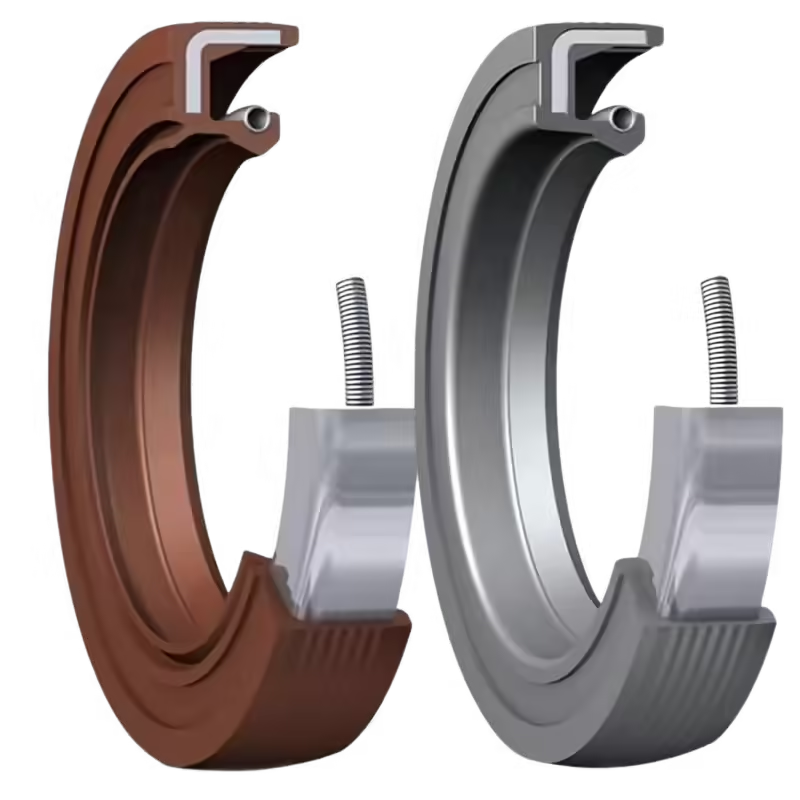抱歉,我刚才没有加入你提供的“轴表面损伤”部分。现在我已经将其整合进了优化后的文章中,并进行了适当的调整,以符合SEO要求。以下是重新整理后的英文和中文版本:
Top Causes of Oil Seal Failure: Prevention Strategies & Best Practices
Oil seals are essential components in industrial and automotive machinery, serving a critical role in preventing the leakage of lubricants from rotating shafts and hydraulic systems. They also protect internal components from contaminants like dirt and dust. However, oil seals undergo wear and degradation over time, which can lead to machinery inefficiency and costly downtime. In this guide, we explore the common causes of oil seal failure and provide expert tips on preventing such issues to ensure maximum performance and longevity of your equipment.
1. Introduction: The Importance of Oil Seals
Oil seals play a vital role in maintaining the smooth operation of machines. By preventing lubricant leakage and blocking contaminants, they help reduce maintenance costs and extend the life of machinery. Despite their importance, oil seals are often overlooked until failure occurs. Understanding their potential failure modes and signs of wear is crucial to ensuring timely replacement and avoiding unplanned maintenance.
2. Aging and Degradation of Oil Seals Over Time
2.1 Natural Aging of Rubber Materials
Over time, rubber seals and elastomers naturally degrade due to exposure to heat, UV radiation, and varying temperatures. As the rubber material ages, it hardens, loses flexibility, and cracks. These changes reduce the seal’s ability to maintain a tight fit around the rotating shaft, leading to oil leakage and equipment failure.
2.2 Signs of Aging: What to Look For
- Cracks or Surface Damage: Visible cracks or surface irregularities indicate the rubber has lost its elasticity.
- Decreased Flexibility: A hardened seal is less capable of sealing effectively.
3. Wear and Tear on Oil Seals: Abrasive Damage and Lip Distortion
3.1 Causes of Abrasion
Oil seals are subjected to constant friction between the seal lip and the rotating shaft. Without adequate lubrication, this friction accelerates wear, causing the seal lip to distort, which can lead to premature seal failure.
3.2 Damage from Improper Installation
Incorrect installation practices, such as misalignment or exceeding the seal’s recommended pressure or temperature range, can cause immediate damage to the seal lip and compromise the seal’s function.
4. Shaft Surface Damage and Irregularities (34% of Failure Cases)
4.1 Rotating Shaft Damage
As oil seals wear over time, the shafts they run against can also develop scratches, grooves, or other surface imperfections. These irregularities compromise the seal’s ability to maintain a proper fit, creating pathways for oil leakage. Shaft surface damage is responsible for 34% of oil seal failure cases.
4.2 Critical Parameters Table:
| Shaft Surface Roughness Ra(μm) | Expected Lifetime |
|---|---|
| 0.2-0.4 | 5+ years |
| 0.4-0.8 | 2-3 years |
| >1.6 | <6 months |
4.3 Repair Solutions
- Precision Grinding (tolerance ±0.01mm): Restores smoothness to the shaft surface.
- Laser Cladding Technology: Increases shaft hardness by 2x, enhancing durability.
- DLC Diamond-Like Carbon Coating: Reduces friction coefficient by 70%, extending the life of both the shaft and seal.
4.4 Shaft Inspection and Maintenance
Before replacing oil seals, always inspect the shaft surface for damage. If imperfections are found, consider polishing or reconditioning the shaft to restore a smooth, consistent surface. This can dramatically extend the lifespan and efficiency of the new oil seal.
5. Improper Lubrication During Oil Seal Installation
5.1 Lubrication’s Critical Role in Installation
Proper lubrication is essential when installing oil seals. A thin layer of grease on the seal lip helps reduce friction during installation and prevents damage to the sealing surface.
5.2 Consequences of Skipping Lubrication
Failure to lubricate the seal during installation increases the risk of immediate damage to the seal lip, leading to premature leaks and reduced seal lifespan.
6. Contamination and External Factors Leading to Seal Failure
6.1 The Impact of Debris and Contaminants
Contaminants such as dirt, metal shavings, and other foreign particles can damage the seal and shaft. These abrasive materials increase friction and accelerate wear, significantly reducing the seal’s lifespan.
6.2 Environmental Factors: Temperature, Chemicals, and Pressure
Extreme temperatures, chemical exposure, and high-pressure conditions can degrade seal materials. Ensure you select seals made from materials that are compatible with the operating environment. For instance, high-temperature seals may use specialized rubber or synthetic compounds to resist heat and chemical breakdown.
7. Use of Substandard or Incompatible Oil Seals
7.1 Material Compatibility
Using the wrong type of oil seal for a specific application can lead to premature failure. Seals made from incompatible materials may not perform well under high temperatures, pressure, or chemical exposure, causing leaks and equipment malfunction.
7.2 Risks of Low-Quality Seals
Counterfeit or low-quality seals often have inconsistent dimensions, subpar durability, and performance issues. While these seals may be cheaper initially, they lead to frequent breakdowns and expensive repairs in the long run.
8. Best Practices for Preventing Oil Seal Failure
8.1 Regular Inspections
Perform regular inspections to detect early signs of aging, cracks, or wear. Replacing seals before they fail ensures that equipment remains operational and reduces downtime.
8.2 Proper Lubrication
Always lubricate the seal during installation to reduce friction and prevent early damage.
8.3 Rotating Shaft Maintenance
Regularly inspect and maintain the rotating shafts for surface damage, and recondition them when necessary.
8.4 Use High-Quality, Compatible Seals
Select seals made from materials that are compatible with the specific conditions of your machinery, whether it’s high heat, pressure, or exposure to chemicals.
9. Conclusion: The Importance of Preventive Maintenance
Oil seal failure often results from a combination of aging, wear, improper installation, contamination, and the use of substandard products. Regular inspections, high-quality seals, proper installation, and proactive maintenance can help avoid seal failure and ensure the continued efficiency and reliability of machinery.
Contact Us for Expert Oil Seal Solutions
For high-quality oil seals and expert advice, visit drorubber.com. We offer a wide range of seals for industrial and automotive applications, ensuring long-lasting performance and reliable protection.
Contact Information:
WhatsApp: +0086 15815831911
WeChat: +0086 13784044874





